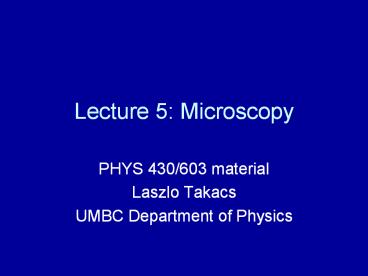Lecture 5: Microscopy - PowerPoint PPT Presentation
Title:
Lecture 5: Microscopy
Description:
Lecture 5: Microscopy PHYS 430/603 material Laszlo Takacs UMBC Department of Physics Light microscopy The principle and a commercial scope Optical microscope (OM) and ... – PowerPoint PPT presentation
Number of Views:185
Avg rating:3.0/5.0
Title: Lecture 5: Microscopy
1
Lecture 5 Microscopy
- PHYS 430/603 material
- Laszlo Takacs
- UMBC Department of Physics
2
Light microscopyThe principle and a commercial
scope
Useful sites http//www.microscopyu.com/articles
/optics/components.html http//em-outreach.ucsd.ed
u/web-course/toccontents.html
3
Optical microscope (OM) and transmission electron
microscope (TEM)
4
TEM modesComposite image, bright field image,
dark field image, selected area diffraction
Transmitted and diffracted beams
Diffraction pattern
First image
Bright field Bright field, transmitted electrons
only Dark field Selected area
diffraction pattern
5
Comparing imaging and diffraction in a TEM.
6
Electron diffraction from amonocrystal polycrys
tal glass
7
How do scanning microscopies work?
- Measurement generates a value for every location
- Reflectivity of light (scanner)
- Ejected electrons (SEM)
- Current between tip and surface (STM)
- Force between tip and surface (AFM)
- Any quantity of interest that can produce
useful contrast
0 2 1 2 2 1 1 1
1 9 7 2 1 8 7 0
2 8 6 1 2 9 8 1
0 8 8 1 8 7 0 1
1 9 7 9 6 0 1 1
1 7 8 8 7 1 1 0
2 9 8 8 6 1 2 1
1 8 9 2 9 7 1 1
0 8 7 1 1 8 3 1
2 1 1 0 2 1 0 1
Interpret numbers as intensities for display or
printer. Digital image processing.
Image table of numbers
8
How do scanning microscopies work?
- Measurement generates a value for every location
- Reflectivity of light (scanner)
- Ejected electrons (SEM)
- Current between tip and surface (STM)
- Force between tip and surface (AFM)
- Any quantity of interest
0 2 1 2 2 1 1 1
1 9 7 2 1 8 7 0
2 8 6 1 2 9 8 1
0 8 8 1 8 7 0 1
1 9 7 9 6 0 1 1
1 7 8 8 7 1 1 0
2 9 8 8 6 1 2 1
1 8 9 2 9 7 1 1
0 8 7 1 1 8 3 1
2 1 1 0 2 1 0 1
Interpret numbers as intensities for display or
printer. Digital image processing.
Image table of numbers
9
- The principle of the SEM.
- There is no image formation in the optical sense.
- This is classical analog system. Modern SEMs
record the measured intensities in a computer
memory rather then project them directly on a CRT
screen. This way image processing is possible
before the final image is created. TV does the
same.
10
Measurable effect caused by high-energy electrons
11
Typical morphological contrast by secondary
electrons.It only looks like an illuminated
landscape. The contrast comes from how many
secondary electrons are generated and how
efficiently they are collected by the detector.
The illumination comes from above, the detector
is n the side.
12
Magnifications very different features are seen
on different length scales
13
Depth of field
14
X-ray analysis
15
Images of a Lunar rock(a) Backscattered
electrons (depend on Z)(c) Fe X-rays(d) P
X-rays(b) Sketch of phases m metal tr
trolite, FeS sc Fe-Ni phosphide wh
phosphate
16
The principle of STM/AFM































